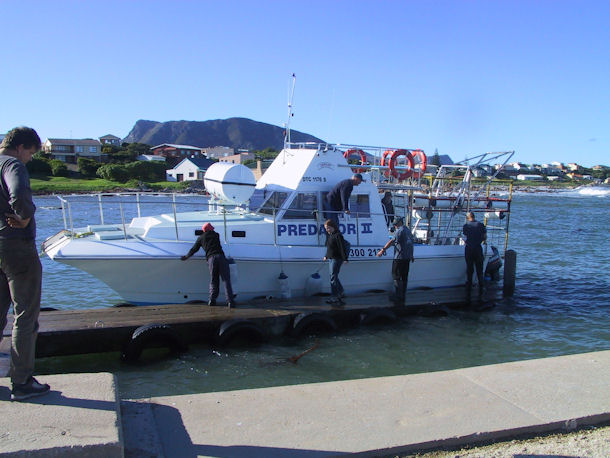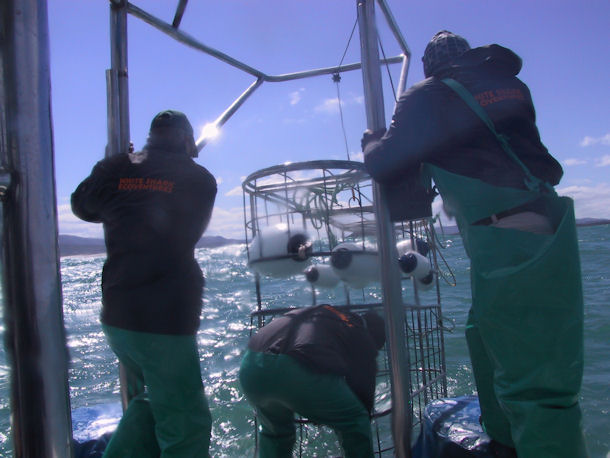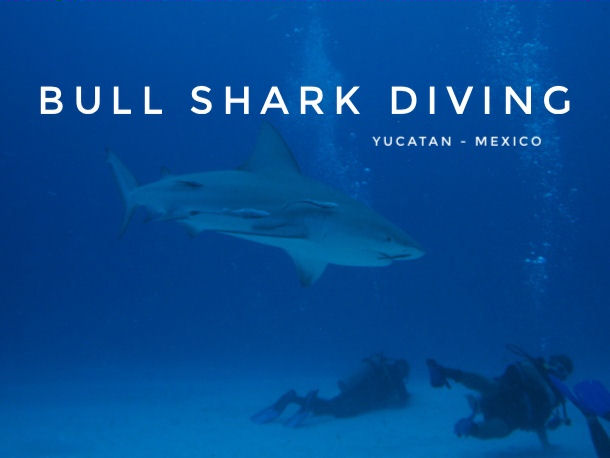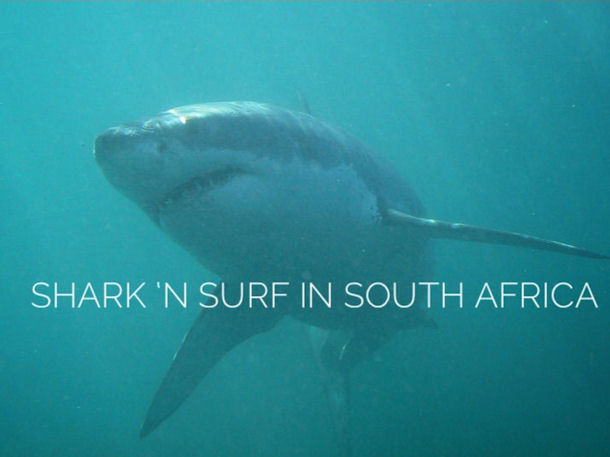by Roger Blum
Behind the bars
Great White Shark Cage Diving in South Africa
Equipped with a spacious protective cage, some tuna fish, large quantities of blood, and the heads of several grey sharks, I set out in June in search of one of the ocean’s most feared predators, the great white shark.
The starting point of our search was the small South African village of Kleinbaai. I left the harbour on board the Predator II, heading for Dyer Island. The island is home to a large population of blue-footed boobies and African penguins. Nearby Geyser Rock, the smaller of the two islands, is home to thousands of South African fur seals. Between the two isles is a 150m wide, 600m long channel called Shark Alley. It is considered one of the best areas for white shark spotting in the world. This is where the warm "Agulhas current" that comes from the Indian Ocean and the cold "Benguela current" from the south meet. The juncture of the two currents appears to attract the great whites, particularly during the winter, and with the large number of seals that frequent the Alley, sharks gather here in large numbers.
|
|

|
|
Predator II in harbour of Kleinbaai
|
|
Once we got to the dive site, Tour Operator Brain McFarlane started to leave a trail of blood and fish waste in the water. As sharks can detect a drop of blood amongst a million drops of water, the chances that one would soon pick up the scent weren’t bad. Still, it can often take several days for the sharks to appear, and sometimes there are no sightings at all. So I waited for a long time and as I stared at the water’s surface, I thought back to last week's experiences: the tour through the Namib Desert, the elephants, rhinos, zebras, giraffes and antelopes in Etosha National Park and the jackals that roamed the camp in the evening. In contrast to the dry heat of Namibia, it was quite cold here at the Cape of Good Hope. But during South African winter the chance to see white sharks was at its best.
|
|

|
|
A heavy swell, the smell of excrement from numerous seals and birds, as well as the unpleasant smell of bait can cause considerable problems for those with sensitive stomachs, and the wait to actually see a shark can be a long one. But I was lucky. Not only did the weather hold out, but it took less than half an hour for the first dorsal fin to appear above the water’s surface.
|
|
Our first Great White Shark
|
|
The cage was hastily lowered and I had the chance to be one of the first to jump into the steel pen. We could see about 10 meters in front of us in the 16-degree-cold water, but despite the high visibility, there wasn’t a trace of a shark to be seen.
|
|

|
|
Suddenly, out of nowhere, one appeared in front of me. At around four metres long, the magnificent animal slowly circled the cage, the boat and the lump of tuna lying in the water. Disappearing back into the void, he then emerged from another direction. Nothing could be felt of the blind aggressiveness that is often associated with the great white. In contrast, he turned out to be extremely cautious. The shark would first circle around the bait, sometimes lunging at the lure. After several unsuccessful attempts, as Brian would pull the meaty-treat out from under his nose, the animal decided on a new strategy: The shark was now swimming at the bait from below. A few meters away from the lure, it would accelerate so rapidly that a part of its massive body would be lifted out of the water.
|
|
I got used to the presence of the mighty predator quite quickly. I didn’t feel any of my initial fear. In fact, because the water was so cold, I even sat down on the floor of the cage, only standing up again when Brain indicated that a shark was approaching the bait. My companion couldn't resist stroking one of the great whites through the bars of our metal pen.
|
|
In the following hours we saw about eight different white sharks, from the "small" three-meter variety to five-meter monsters. On several occasions, two sharks would circle the boat at the same time. When they met, the smaller shark would always give way to the larger one. Despite the sense of security from behind the bars, it did not escape our notice that without the cage, we would have definitely been the lowest in the pecking order.
|
|

Meet The Bull Sharks
The real reason I went to Mexico was actually to photograph the fauna and flora in freshwater cavern areas far away from the ocean. Here in the jungle, there are colorful cichlids, tooth carp, catfish and tetrasa, all of which we know from our native aquariums, as well as blind cave fish and turtles. But I was drawn to the ocean when I was given the opportunity by a small group of adventurous divers to swim with bull sharks.
[read more]
|
|
|

Shark 'n Surf in South Africa
Ever since Steven Spielberg’s underwater blockbuster ‘Jaws’ hit cinemas in 1975, people who swim in the sea have been divided into two camps: those who hope that they’ll never come face-to-face with a shark, and those who actively seek them out. I am one of the latter. Inspired by the celebrated film and its anti-hero, the great white shark, I try to dive with the elegant hunters whenever and wherever I can. On this occasion, I was in the coastal town of Gansbaai, two hours south of Cape Town.
[read more]
|
|
|
|


